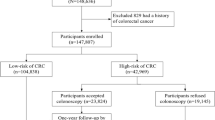Abstract
Objective
To confirm an effective and practicable screening model for early detection of colorectal cancer (CRC), and to modify an acceptable and reasonable staging of CRC for predicting prognosis and to define the therapeutic strategy.
Methods
Data from 3 case-control studies have been used for selecting the high risk factors of CRC to optimize Sequencing Screening Model (SSM). The fieldwork recalls have been utilized to compare the sensitivity, specificity and Youden Index between the SSM and the optimized one. The 1722 individuals have been used to evaluate the Optimized Sequencing Screening Model (OPSM). From 1980 to 1995, 1334 cases of CRC pathologically confirmed have been analyzed for 3-, 5- and 10-year survival rates. All tests were performed at the 0.05 level of significances. Statistical analysis was conducted by using the SPSS 10.0 statistic software.
Results
A simple questionnaire and RPHA-FOB test as the screening model for early detecting CRC had been proved as an optimized screening model. The sensitivity, specificity and Youden Index of the optimized model were higher than those of SSM. From the 1722 individuals 4 Dukes' A and 5 Dukes' B CRC were screened out. Analysis of the 3-, 5- and 10-year survival rates revealed that there were statistically significant differences between serosa and extraserosa. The 3-, 5- and 10-year survival rates were 0.91±0.06, 0.84±0.07, 0.81±0.07 respectively in cancer involved to the serosa group, but in extraserosa group the survival rates were 0.82±0.03, 0.74±0.03, 0.63±0.04 respectively. The survival rate of serosa level involved was higher than that of extraserosa and/or rectum wall fat. Therefore, these two levels should be separated in the clinico-pathologic staging of CRC.
Conclusion
The optimized screening model is suitable to early detection of the CRC. Due to different survival rates of different layers involved, the Dukes B (or stage II) should be divided into Dukes B1 or stage II a (serosa) and Dukes B2 or stage IIb (extraserosa or bowel wall fat).
Similar content being viewed by others
Reference
Li LD, Lu FZ, Zhang SW. Analyses of variation trend and short-term detection of Chinese malignant tumor mortality during twenty years. J Chin Oncol, 1997, 19(1):3–9.
Yang G, Zheng S, Jin F, et al. Pathogeny study of variation trend of colorectal cancer incidents. J Pract Oncol, 1998, 13(3):136–137.
Jiao DA, Shen GF, Shen YZ, et al. A case-control study of recteo-colon cancer. J Chin Epidemiol 1985, (5):285–288.
Jiao DA, Wu DR, Chen K, et al. A survey of risk factors of colorectal cancer in high-incidence area Jiashan county. J Chin Epidemiol, 1988, (6): 354–357.
Zheng S, Zhou L, Yu H, et al. A case-control study of colorectal cancer among six large regions in China. Onology, 1995, 15(2):149–151.
Lee MM, Wu-Williams A, Whittemore AS, et al. Comparison of dietary habits, physical activity and body size among Chinese in North America and China. Int J of Epidemiology, 1994, 23(5):984–990.
Whittemore AS, Wu-williams AH, Lee M, et al. Diet, physical activity and colorectal cancer among Chinese in North America and China. J Natl Cancer Inst, 1990, 82(11):915–926.
Chen K, Jiao DA, Yu H, et al. An applied study on the method of multifactorial quantitative-risk assessment (MFQRA) for mass screening of colorectal cancer. J Chin Oncol, 1993, 15(1):37–40.
Zheng S, Wu JM, Zhou RB, et al. The screening model for early diagnosis of colorectal cancer in general population. Chin J Med, 1991, 71(7):381–384, 28.
Liu XY, Zhou L, Yu H, et al. A case-control study of 286 cases colorectal cancer in Jiashan county. J Prev Treat Chroni Dis, 1994, 2(3):122–123.
Zhou L, Yu H, Chen K, et al. Risk factors of colorectal adenoma in high-prevalent area. Chin Oncol Clin, 1994, 21(12):884–887.
Yang G, Zhang XL, Zheng S, et al. The role of common symptoms in screening of large bowel cancer: a population-based case control study in Shanghai. Chin Oncol Clin, 1995, 22(6):403–407.
Zhou L, Yu H, Zheng S. Evaluation of optimized screening model in high prevalent area. J Prev Treat Chroni Dis, 1997, 5:75–76.
Liu XY, Zheng S, Yang G, et al. Evaluation of optimized screening model in high-risk population. Res Oncol Prev Treat, 1997, 24(4):197–199.
Sugarbaker PH, Gunderson IL, Wittes RE. Colorectel cancer. In DeVita VT Jr, Hellman S, Roseberg SA, eds. Cancer Principles and Practices of Oncology, 2nd ed. Philadelphia: JB Lippincott, 1995. 795–884.
Author information
Authors and Affiliations
Corresponding author
Rights and permissions
About this article
Cite this article
Zheng, S., Cai, S. & Qu, J. Study on the early detection and clinico-pathologic staging of colorectal cancer in China. Chin. -Ger. J. Clin. Oncol. 1, 68–71 (2002). https://doi.org/10.1007/BF02851736
Received:
Issue Date:
DOI: https://doi.org/10.1007/BF02851736




